
The American Kennel Club (AKC) is a registry of purebred dog pedigrees in the United States. In addition to maintaining its pedigree registry, this kennel club also promotes and sanctions events for purebred dogs, including the Westminster Kennel Club Dog Show, an annual event which predates the official forming of the AKC, the National Dog Show and the AKC National Championship. The AKC is a non-member partner with the Fédération Cynologique Internationale. The AKC recognizes 200 dog breeds, as of 2022.

The Shih Tzu is a toy dog or pet dog breed originating from Tibet and believed to be bred from the Pekingese and the Lhasa Apso.
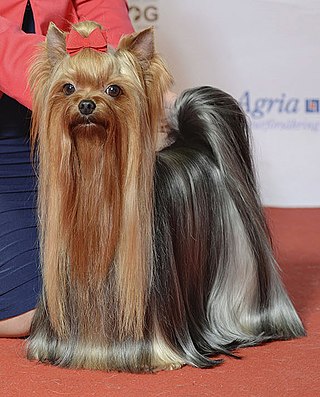
The Yorkshire Terrier, also known as a Yorkie, is a British breed of toy dog of terrier type. It is among the smallest of the terriers and indeed of all dog breeds, with a weight of no more than 3.2 kg (7 lb). It originated in the nineteenth century in the English county of Yorkshire, after which it is named. The coat is tan on the head and dark steel-grey on the body; no other colour is accepted by either The Kennel Club or the Fédération Cynologique Internationale.

Collies form a distinctive type of herding dogs, including many related landraces and standardized breeds. The type originated in Scotland and Northern England. Collies are medium-sized, fairly lightly-built dogs, with pointed snouts. Many types have a distinctive white color over the shoulders. Collies are very active and agile, and most types of collies have a very strong herding instinct. Collie breeds have spread through many parts of the world, and have diversified into many varieties, sometimes mixed with other dog types.
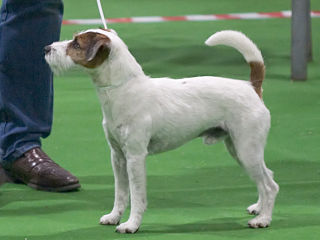
The Parson Russell Terrier is a breed of small white terrier that was the original Fox Terrier of the 18th century. The breed is named after the Reverend Jack Russell, credited with the creation of this type of dog. It is the recognised conformation show variety of the Jack Russell Terrier and was first recognised in 1990 in the United Kingdom as the Parson Jack Russell Terrier. In America, it was first recognised as the Jack Russell Terrier in 1997. The name was changed to its current form in 1999 in the UK and by 2008 all international kennel clubs recognised it under the new name.
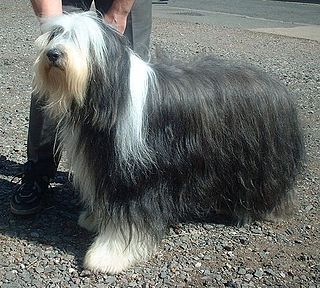
The Bearded Collie, or Beardie, is a herding breed of dog once used primarily by Scottish shepherds, but now mostly a popular family companion.

The soft-coated Wheaten Terrier is a pure-breed terrier originating from Ireland. Wheatens typically have one of two coat types: Irish or Heavy (American). The Irish coat is generally silkier and wavier than the Heavy, or American coat, which is thicker and fuller. Wheatens are generally friendly and playful, and tend to get along well with children and other dogs.
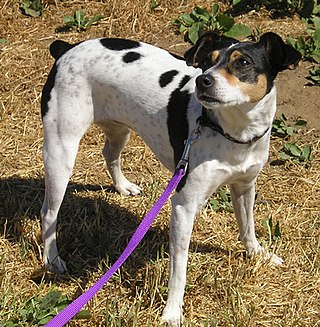
The Rat Terrier is an American dog breed with a background as a farm dog and hunting companion. They share much ancestry with the small hunting dogs known as feists. Common throughout family farms in the 1920s and 1930s, they are now recognized by the United (UKC) and American Kennel Clubs (AKC) and are considered a rare breed. Rat Terriers are an intelligent and active breed that can be kept both for pest control and as a family pet.

The Toy Fox Terrier is a small terrier breed of dog, directly descended from the larger Smooth Fox Terrier but since 1936, it has been registered in the USA with the UKC as a separate breed.
Toy dog traditionally refers to a very small dog or a grouping of small and very small breeds of dog. A toy dog may be of any of various dog types. Types of dogs referred to as toy dogs may include spaniels, pinschers and terriers that have been bred down in size. Not all toy dogs are lap dogs.
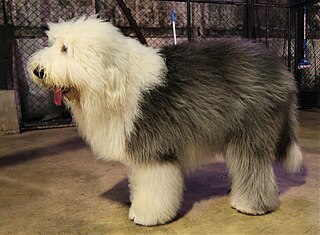
The Old English Sheepdog is a large breed of dog that emerged in England from early types of herding dog. Obsolete names for the breed include Shepherd's Dog and bob-tailed sheep-dog. The nickname Bob-tail originates from how dogs of the breed traditionally had their tails docked. Old English Sheepdogs can grow very long coats with fur covering the face and eyes and do not shed unless brushed.
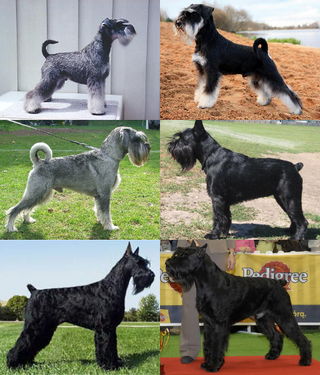
A Schnauzer is a dog breed type that originated in Germany from the 14th to 16th centuries. The term comes from the German word for "snout" and means colloquially "moustache", or "whiskered snout", because of the dog's distinctively bearded snout. Initially it was called Wire-Haired Pinscher, while Schnauzer was adopted in 1879.

The Lhasa Apso is a non-sporting dog breed originating in Tibet. Traditionally the breed has been used as an interior watchdog.
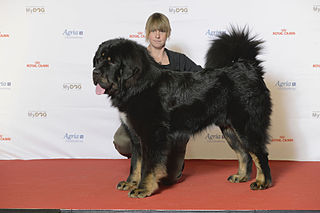
The Tibetan Mastiff is a large size Tibetan dog breed. Its double coat is medium to long, subject to climate, and found in a wide variety of colors, including solid black, black and tan, various shades of red and bluish-gray, and sometimes with white markings around neck, chest and legs.

The Black Russian Terrier, also known as the Chornyi Terrier, is a breed of dog created in USSR in Red Star Kennel during the late 1940s and the early 1950s for use as military/working dogs. At the present time, the Black Russian Terrier is a breed recognized by the FCI, AKC, CKC, KC, ANKC, NZKC and other cynological organizations. The contemporary Black Russian Terrier is a working dog, guarding dog, sporting and companion dog.

A companion dog is a dog which is not primarily a working dog but a pet. The primary function of a companion dog is not to perform a useful job but to provide companionship to humans. A companion dog can also be called an emotional support animal and is used to help people with mental health disabilities cope with symptoms. Most dogs can be companions, including many working dog breeds such as retrievers, who are enjoyed primarily for their friendly nature as a pet. Most toy dog breeds are used only for the pleasure of their company, not as workers. The American Kennel Club also offers a Companion dog title for judged dog obedience competitions.
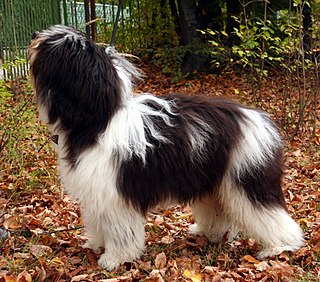
The Polish Lowland Sheepdog, is a medium-sized, shaggy-coated, sheep dog breed native to Poland.

The Sussex Spaniel is a breed of dog native to Sussex in southern England. It is a low, compact spaniel and is as old a breed as and similar in appearance to the Clumber Spaniel. They can be slow-paced, but can have a clownish and energetic temperament. They suffer from health conditions common to spaniels and some large dogs, as well as a specific range of heart conditions and spinal disc herniation.

The Russian Toy is a very small breed of dog originally bred in Russia from the English Toy Terrier. There are two types of coats in the breed: smooth coat and long coat. The smooth-coated variety was previously known as the Russian Toy Terrier and long-coated as the Moscow Long-Haired Toy Terrier. Both were brought together under the same Russian Toy Terrier name in 1988 and the "Terrier" was dropped from the name when the breed was added in 2006 to the official list of breeds registered with the Fédération Cynologique Internationale and has been registered in the Foundation Stock Service of the American Kennel Club since 2008, allowed to compete in AKC companion events since 2010. The first official breed standard of the two varieties was written in 1966 in Russia.
The Tibetan Kyi Apso is a medium to large sized breed of livestock guardian dog originating from Tibet and the Himalayas. It is considered an ancient and rare landrace, similar in appearance and stature to its relative, the Tibetan Mastiff.



























